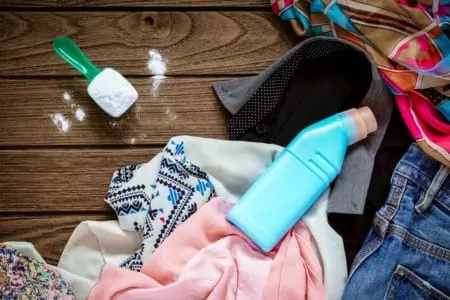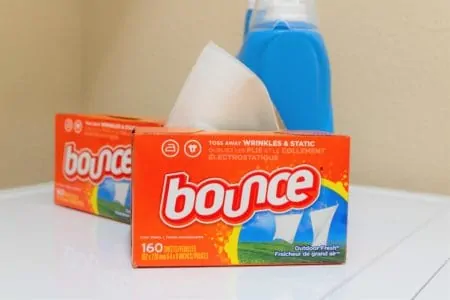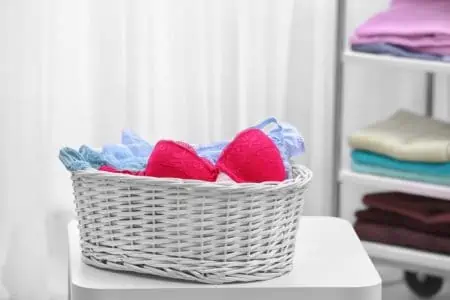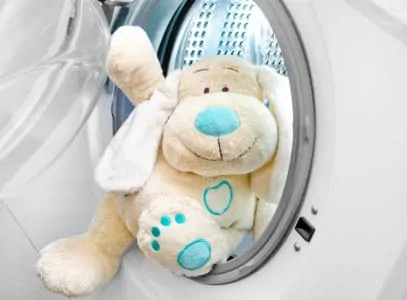Sick of losing your favorite clothes from colors bleeding? We’re here to help.
We’re all aware of what happens when you put a red sock in with white clothes. Everything turns pink! But what if we told you a few ways to stop this from ever happening again?
We’ll teach you how to stop clothes from bleeding to make laundry day easier and ultimately, cheaper. Because ruining a whole load of laundry is an expensive mistake to make.
Key Takeaways
- Color test: Test your clothes for colorfastness. Submerge garments in soapy water. Check if the water has changed color.
- Use cold water: Hot water breaks down dyes and causes clothes to bleed.
- Sort clothes: Sort clothes with similar colors and weight. If bleeding occurs, it won’t be noticeable. Washing heavy and delicate clothes together increases friction which causes more bleeding.
Why Do Clothes Bleed?
Not all fabrics bleed — so, what is the reason behind some fabrics bleeding?
- Crocking: Crocking usually happens while clothes are dry, but it can also happen while wet. The excess dye from one fabric rubs onto another dry fabric. This usually occurs with darker colors. You might have experienced it if you wear a dark sweater over a light t-shirt, and take it off later to find new stains. It’s most common with dyed raw denim though. It’s usually a result of the dye not being properly adhered to the fabric.
- Bleeding: Bleeding, similar to crocking, is when one fabric stains another, but this occurs when the clothes are wet. The dye runs off the clothes while they’re wet and stains the water which then stains other clothes. This tends to happen most often with brightly colored clothes.
- Fading: Fading is when clothes lose their dyes through bleeding, crocking, bleach or exposure to sunlight. This can also occur from the water, friction, detergent and drying method used during a regular laundry day. Clothes will look lighter or less bright than they did before.
How to Stop Clothes Bleeding in the Wash
Crocking, bleeding and fading are all quite scary words, but there’s no reason to fear. With extra caution and knowledge, you can easily stop clothes from bleeding in the wash.
Color Test
Before washing the garment with other clothes, do a color test. The care label will often tell you if an item will bleed. It may say to wash with similar colors, or warn you that the colors may run. But if it doesn’t, and you’re curious, there are two ways to color test.
Hand Wash Separately
If you’re worried about colors bleeding, it’s recommended that you wash the garment by hand separately. This prevents other items of clothing from getting damaged.
Depending on the garment, hand washing instructions will vary.
Use Cold Water
If you want to machine wash the garment with other clothes, always use cold water. Hot water causes more bleeding and staining on other clothes since it can break down the dyes (1). We always recommend cold water for maintaining color and brightness in clothes.
Color Catcher
Color catchers are sheets that go in with your laundry to trap loose dyes. They are meant to prevent clothes from bleeding by stopping dyes from transferring onto other garments. So, you shouldn’t end up with pink towels if you accidentally threw in a red sock.
Color catchers have mixed reviews. This is mostly because if you use them with hot water, your clothes can still fade. Yes, the color catchers might trap dyes and prevent staining or crocking — but clothes can still fade.
Ultimately, these sheets work best in cold water. In that case, however, the clothes probably won’t bleed or fade anyway so there’s not much point in using them.
Dye Fixative
Dye fixatives are intended to reduce bleeding, fading and therefore, transfer to other clothes in the machine. It depends on the product, but these are usually intended for at-home dyeing projects, like tie-dying. Always check the manufacturer instructions to see what the product is intended for.
The molecules in the fixative have a positive charge, whereas the molecules in most dyes have a negative charge (2). So the dyes can be glued into place with the dye fixative.
There are two main drawbacks to fixatives, though. For one, clothes that have been treated by a dye fixative become less resistant to fading from light sources. Secondly, the dye fixative may contain a carcinogen, formaldehyde.
Sort With Similar Colors
Of course, this takes some extra time and planning, but it’s the best way to prevent color staining. Sure, colors might still bleed but it won’t be noticeable if you wash with similar colors.
Laundry Hack
Reduce Friction
To prevent clothes bleeding, think about friction. Friction is a huge factor for clothes bleeding and fading.
First, try using a gentle cycle. This will minimize friction and abrasion, which — especially in cold cycles — should rule out any possibility of color bleeding. Also, don’t overstuff the washing machine.
Second, wash your clothes inside out. This stops clothes fading on the outside.
Wash heavy and delicate clothes separately. Heavy clothes can increase friction in a cycle and transfer their dyes to delicate items.
FAQs About Stopping Clothes From Bleeding
Tips for Preventing Clothes From Bleeding or Fading
For our final top tips, refer to this great list!
- Always turn your clothes inside out when washing them. This will still thoroughly clean clothes, but it reduces friction on the colored side.
- Wash clothes in cold water. Hot water can relax the fibers and allow the colors to bleed more easily.
- Don’t overstuff your washing machine. This can increase friction and agitation which causes colors to bleed and fade.
- If drying clothes outside, don’t hang them in direct sunlight as this can cause fading.
- Always check for colorfastness. If the garment bleeds, wash it separately or with similar colors.
- Wash clothes before wearing to remove excess dye. This stops clothes fading or bleeding in the next wash, but also protects your skin from dye stains.
- Always separate clothes by color and weight.
- Adding a cup of vinegar to your wash won’t stop bleeding, but it can brighten whites and colors to stop the appearance of fading.
- Use short gentle washing cycles where possible, or opt for handwashing.
Keeping Clothes Bright
With these tips to stop your clothes from bleeding, you can keep your clothes bright and reduce fading. This is a common disaster on laundry day and it can take a while to get into the habit of our top tips. But soon enough, you’ll be separating laundry by color and weight as if it were second nature!
With these tips and habits in mind, not only will you save yourself from the nightmare of stained clothes. But you’ll also save money, since ruining an entire load of laundry with a non-colorfast item is a costly mistake to make.
















